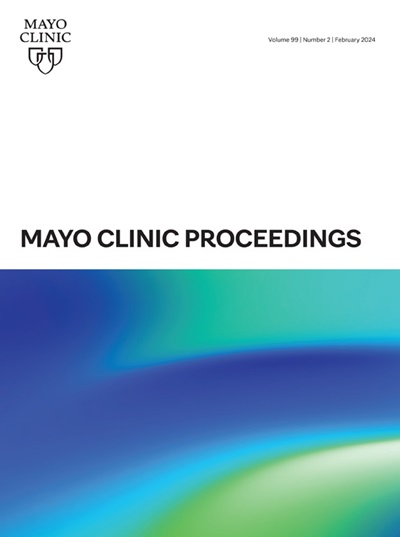Artificial Intelligence–Enhanced Electrocardiography for Prediction of Occult Atrial Fibrillation in Patients With Stroke Who Undergo Prolonged Cardiac Monitoring
IF 6.7
2区 医学
Q1 MEDICINE, GENERAL & INTERNAL
引用次数: 0
Abstract
Objective
To evaluate the performance of an artificial intelligence (AI)–enhanced electrocardiography (ECG; AI-ECG) algorithm to predict atrial fibrillation (AF) detection on prolonged cardiac monitoring (PCM) after index stroke.
Patients and Methods
This retrospective study included all adult patients with ischemic stroke evaluated at Mayo Clinic with baseline ECG and PCM from January 1, 2018, to December 31, 2020. We recorded demographic characteristics, clinical features, presumed stroke mechanism, PCM duration, and PCM outcome (AF vs no AF) and AF burden. Electrocardiograms were analyzed using the AI-ECG algorithm to determine likelihood of AF capture with PCM. Stroke etiology was adjudicated using TOAST (Trial of ORG 10172 in Acute Stroke Treatment) and embolic stroke of undetermined source (ESUS) definitions. The ability of the AI-ECG algorithm to predict AF detected by PCM was assessed via receiver operating characteristics analysis, calculating the area under the receiver operating characteristic curve (C statistic). Sensitivity and specificity analyses were performed for each tool using optimal cutoffs (using maximum Youden indices).
Results
We identified 863 patients for inclusion in the study. The median age was 69 years, 496 (57.5%) were male, 367 (42.5%) were women, and 561 patients (65.0%) were categorized as having ESUS. Prolonged cardiac monitoring detected AF in 85 patients (9.8%). Median duration of PCM was 30 days (IQR, 25 to 30 days). The AI-ECG algorithm identified a notable difference in probability of AF on PCM. For its optimal model output cutoff of 0.24, AI-ECG had a negative predictive value of 94.2% (95% CI, 92.2% to 95.9%) and a specificity of 81.8% (95% CI, 78.9% to 84.4%) for excluding AF on PCM. When evaluating for an AF burden of 6 minutes or longer, the AI-ECG had a negative predictive value of 96.7% (95% CI, 95.5% to 97.6%). There was no significant difference in the area under the receiver operating characteristic curve when comparing the ESUS vs non-ESUS subgroups (P=.42).
Conclusion
This study found that AI-ECG may help identify patients unlikely to have AF on PCM and can predict the occurrence of longer episodes of AF. Thus, AI-ECG may be used to stratify which patients should undergo PCM after stroke. Future studies should compare the performance of AI-ECG and PCM for the clinical end point of stroke recurrence.
人工智能增强心电图预测长时间心脏监测的脑卒中患者隐匿性心房颤动。
目的:评价人工智能(AI)增强心电图(ECG;AI-ECG算法预测指数脑卒中后长时间心脏监测(PCM)心房颤动(AF)检测。患者和方法:本回顾性研究纳入了2018年1月1日至2020年12月31日在梅奥诊所接受基线ECG和PCM评估的所有成年缺血性卒中患者。我们记录了人口学特征、临床特征、假定的卒中机制、PCM持续时间、PCM结果(房颤vs无房颤)和房颤负担。使用AI-ECG算法分析心电图,以确定PCM捕获AF的可能性。卒中病因是通过TOAST (ORG 10172急性卒中治疗试验)和不明来源栓塞性卒中(ESUS)定义来确定的。通过受试者工作特性分析,计算受试者工作特性曲线下面积(C统计量),评估AI-ECG算法对PCM检测到的房颤的预测能力。使用最佳截止点(使用最大约登指数)对每种工具进行敏感性和特异性分析。结果:我们确定了863例患者纳入研究。中位年龄为69岁,男性496例(57.5%),女性367例(42.5%),561例(65.0%)患者被归类为ESUS。延长心脏监测时间发现房颤85例(9.8%)。PCM的中位持续时间为30天(IQR, 25 ~ 30天)。AI-ECG算法识别出心房颤动在PCM上的概率有显著差异。AI-ECG的最佳模型输出截止值为0.24,其阴性预测值为94.2% (95% CI, 92.2%至95.9%),特异性为81.8% (95% CI, 78.9%至84.4%)。当评估6分钟或更长时间的心房颤动负担时,AI-ECG的阴性预测值为96.7% (95% CI, 95.5%至97.6%)。ESUS组与非ESUS组比较,受试者工作特征曲线下面积无显著差异(P= 0.42)。结论:本研究发现AI-ECG可以帮助识别不太可能在PCM上发生房颤的患者,并可以预测房颤长发作的发生。因此,AI-ECG可以用于区分卒中后哪些患者应该进行PCM。未来的研究应该比较AI-ECG和PCM在脑卒中复发临床终点的表现。
本文章由计算机程序翻译,如有差异,请以英文原文为准。
求助全文
约1分钟内获得全文
求助全文
来源期刊

Mayo Clinic proceedings
医学-医学:内科
CiteScore
16.80
自引率
1.10%
发文量
383
审稿时长
37 days
期刊介绍:
Mayo Clinic Proceedings is a premier peer-reviewed clinical journal in general medicine. Sponsored by Mayo Clinic, it is one of the most widely read and highly cited scientific publications for physicians. Since 1926, Mayo Clinic Proceedings has continuously published articles that focus on clinical medicine and support the professional and educational needs of its readers. The journal welcomes submissions from authors worldwide and includes Nobel-prize-winning research in its content. With an Impact Factor of 8.9, Mayo Clinic Proceedings is ranked #20 out of 167 journals in the Medicine, General and Internal category, placing it in the top 12% of these journals. It invites manuscripts on clinical and laboratory medicine, health care policy and economics, medical education and ethics, and related topics.
 求助内容:
求助内容: 应助结果提醒方式:
应助结果提醒方式:


